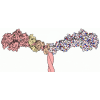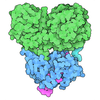[English] 日本語
 Yorodumi
Yorodumi- PDB-7bsw: Cryo-EM structure of a human ATP11C-CDC50A flippase in PtdEtn-occ... -
+ Open data
Open data
- Basic information
Basic information
| Entry | Database: PDB / ID: 7bsw | ||||||||||||||||||||||||
|---|---|---|---|---|---|---|---|---|---|---|---|---|---|---|---|---|---|---|---|---|---|---|---|---|---|
| Title | Cryo-EM structure of a human ATP11C-CDC50A flippase in PtdEtn-occluded E2-AlF state | ||||||||||||||||||||||||
 Components Components |
| ||||||||||||||||||||||||
 Keywords Keywords | MEMBRANE PROTEIN / Flippase / P-type ATPase / P4-ATPase / Phospholipid | ||||||||||||||||||||||||
| Function / homology |  Function and homology information Function and homology informationpositive regulation of phospholipid translocation / aminophospholipid flippase activity / aminophospholipid transport / phosphatidylserine flippase activity / protein localization to endosome / phospholipid-translocating ATPase complex / ATPase-coupled intramembrane lipid transporter activity / positive regulation of protein exit from endoplasmic reticulum / phosphatidylserine floppase activity / phosphatidylethanolamine flippase activity ...positive regulation of phospholipid translocation / aminophospholipid flippase activity / aminophospholipid transport / phosphatidylserine flippase activity / protein localization to endosome / phospholipid-translocating ATPase complex / ATPase-coupled intramembrane lipid transporter activity / positive regulation of protein exit from endoplasmic reticulum / phosphatidylserine floppase activity / phosphatidylethanolamine flippase activity / xenobiotic transmembrane transport / P-type phospholipid transporter / azurophil granule membrane / phospholipid translocation / transport vesicle membrane / Ion transport by P-type ATPases / specific granule membrane / positive regulation of neuron projection development / recycling endosome / recycling endosome membrane / late endosome membrane / early endosome membrane / monoatomic ion transmembrane transport / apical plasma membrane / lysosomal membrane / endoplasmic reticulum membrane / Neutrophil degranulation / structural molecule activity / magnesium ion binding / endoplasmic reticulum / Golgi apparatus / ATP hydrolysis activity / ATP binding / membrane / plasma membrane Similarity search - Function | ||||||||||||||||||||||||
| Biological species |  Homo sapiens (human) Homo sapiens (human) | ||||||||||||||||||||||||
| Method | ELECTRON MICROSCOPY / single particle reconstruction / cryo EM / Resolution: 3.9 Å | ||||||||||||||||||||||||
 Authors Authors | Abe, K. / Nishizawa, T. / Nakanishi, H. | ||||||||||||||||||||||||
| Funding support |  Japan, 3items Japan, 3items
| ||||||||||||||||||||||||
 Citation Citation |  Journal: Cell Rep / Year: 2020 Journal: Cell Rep / Year: 2020Title: Transport Cycle of Plasma Membrane Flippase ATP11C by Cryo-EM. Authors: Hanayo Nakanishi / Tomohiro Nishizawa / Katsumori Segawa / Osamu Nureki / Yoshinori Fujiyoshi / Shigekazu Nagata / Kazuhiro Abe /  Abstract: ATP11C, a plasma membrane phospholipid flippase, maintains the asymmetric distribution of phosphatidylserine accumulated in the inner leaflet. Caspase-dependent inactivation of ATP11C is essential ...ATP11C, a plasma membrane phospholipid flippase, maintains the asymmetric distribution of phosphatidylserine accumulated in the inner leaflet. Caspase-dependent inactivation of ATP11C is essential for an apoptotic "eat me" signal, phosphatidylserine exposure, which prompts phagocytes to engulf cells. We show six cryo-EM structures of ATP11C at 3.0-4.0 Å resolution in five different states of the transport cycle. A structural comparison reveals phosphorylation-driven domain movements coupled with phospholipid binding. Three structures of phospholipid-bound states visualize phospholipid translocation accompanied by the rearrangement of transmembrane helices and an unwound portion at the occlusion site, and thus they detail the basis for head group recognition and the locality of the protein-bound acyl chains in transmembrane grooves. Invariant Lys880 and the surrounding hydrogen-bond network serve as a pivot point for helix bending and precise P domain inclination, which is crucial for dephosphorylation. The structures detail key features of phospholipid translocation by ATP11C, and a common basic mechanism for flippases is emerging. | ||||||||||||||||||||||||
| History |
|
- Structure visualization
Structure visualization
| Movie |
 Movie viewer Movie viewer |
|---|---|
| Structure viewer | Molecule:  Molmil Molmil Jmol/JSmol Jmol/JSmol |
- Downloads & links
Downloads & links
- Download
Download
| PDBx/mmCIF format |  7bsw.cif.gz 7bsw.cif.gz | 230.2 KB | Display |  PDBx/mmCIF format PDBx/mmCIF format |
|---|---|---|---|---|
| PDB format |  pdb7bsw.ent.gz pdb7bsw.ent.gz | 169.7 KB | Display |  PDB format PDB format |
| PDBx/mmJSON format |  7bsw.json.gz 7bsw.json.gz | Tree view |  PDBx/mmJSON format PDBx/mmJSON format | |
| Others |  Other downloads Other downloads |
-Validation report
| Summary document |  7bsw_validation.pdf.gz 7bsw_validation.pdf.gz | 868.2 KB | Display |  wwPDB validaton report wwPDB validaton report |
|---|---|---|---|---|
| Full document |  7bsw_full_validation.pdf.gz 7bsw_full_validation.pdf.gz | 938.7 KB | Display | |
| Data in XML |  7bsw_validation.xml.gz 7bsw_validation.xml.gz | 43.7 KB | Display | |
| Data in CIF |  7bsw_validation.cif.gz 7bsw_validation.cif.gz | 63.6 KB | Display | |
| Arichive directory |  https://data.pdbj.org/pub/pdb/validation_reports/bs/7bsw https://data.pdbj.org/pub/pdb/validation_reports/bs/7bsw ftp://data.pdbj.org/pub/pdb/validation_reports/bs/7bsw ftp://data.pdbj.org/pub/pdb/validation_reports/bs/7bsw | HTTPS FTP |
-Related structure data
| Related structure data |  30169MC  7bspC  7bsqC  7bssC  7bsuC  7bsvC M: map data used to model this data C: citing same article ( |
|---|---|
| Similar structure data |
- Links
Links
- Assembly
Assembly
| Deposited unit | 
|
|---|---|
| 1 |
|
- Components
Components
-Protein , 2 types, 2 molecules AC
| #1: Protein | Mass: 124403.617 Da / Num. of mol.: 1 Mutation: Deletion of 7 a.a. at N-term, and 38 a.a. at C-term Source method: isolated from a genetically manipulated source Source: (gene. exp.)  Homo sapiens (human) / Cell line (production host): Expi293 / Production host: Homo sapiens (human) / Cell line (production host): Expi293 / Production host:  Homo sapiens (human) / References: UniProt: Q8NB49*PLUS Homo sapiens (human) / References: UniProt: Q8NB49*PLUS |
|---|---|
| #2: Protein | Mass: 40900.801 Da / Num. of mol.: 1 / Mutation: N180Q, S292W Source method: isolated from a genetically manipulated source Source: (gene. exp.)  Homo sapiens (human) / Cell line (production host): Expi293 / Production host: Homo sapiens (human) / Cell line (production host): Expi293 / Production host:  Homo sapiens (human) / References: UniProt: Q9NV96*PLUS Homo sapiens (human) / References: UniProt: Q9NV96*PLUS |
-Sugars , 2 types, 5 molecules 
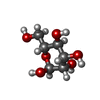

| #5: Sugar | ChemComp-NAG / #6: Sugar | ChemComp-MAN / | |
|---|
-Non-polymers , 2 types, 2 molecules 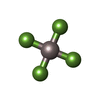
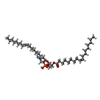

| #3: Chemical | ChemComp-ALF / |
|---|---|
| #4: Chemical | ChemComp-PEE / |
-Details
| Has ligand of interest | Y |
|---|---|
| Has protein modification | Y |
| Sequence details | NCBI Reference Sequence accession IDs are NCBI XM_005262405.1 for ATP11C and NP_001340741.2 for CDC50A. |
-Experimental details
-Experiment
| Experiment | Method: ELECTRON MICROSCOPY |
|---|---|
| EM experiment | Aggregation state: PARTICLE / 3D reconstruction method: single particle reconstruction |
- Sample preparation
Sample preparation
| Component | Name: human ATP11C-CDC50A flippase / Type: COMPLEX / Entity ID: #1-#2 / Source: RECOMBINANT |
|---|---|
| Molecular weight | Value: 0.18 MDa / Experimental value: NO |
| Source (natural) | Organism:  Homo sapiens (human) Homo sapiens (human) |
| Source (recombinant) | Organism:  Homo sapiens (human) / Cell: Expi293 Homo sapiens (human) / Cell: Expi293 |
| Buffer solution | pH: 6.5 |
| Specimen | Conc.: 8 mg/ml / Embedding applied: NO / Shadowing applied: NO / Staining applied: NO / Vitrification applied: YES |
| Vitrification | Instrument: FEI VITROBOT MARK IV / Cryogen name: ETHANE / Humidity: 99 % / Chamber temperature: 298 K |
- Electron microscopy imaging
Electron microscopy imaging
| Experimental equipment |  Model: Titan Krios / Image courtesy: FEI Company |
|---|---|
| Microscopy | Model: TFS KRIOS |
| Electron gun | Electron source:  FIELD EMISSION GUN / Accelerating voltage: 300 kV / Illumination mode: FLOOD BEAM FIELD EMISSION GUN / Accelerating voltage: 300 kV / Illumination mode: FLOOD BEAM |
| Electron lens | Mode: BRIGHT FIELD |
| Image recording | Electron dose: 64 e/Å2 / Film or detector model: GATAN K3 (6k x 4k) |
- Processing
Processing
| Software |
| ||||||||||||||||||||||||
|---|---|---|---|---|---|---|---|---|---|---|---|---|---|---|---|---|---|---|---|---|---|---|---|---|---|
| EM software |
| ||||||||||||||||||||||||
| CTF correction | Type: PHASE FLIPPING AND AMPLITUDE CORRECTION | ||||||||||||||||||||||||
| 3D reconstruction | Resolution: 3.9 Å / Resolution method: FSC 0.143 CUT-OFF / Num. of particles: 400000 / Symmetry type: POINT | ||||||||||||||||||||||||
| Atomic model building | Protocol: RIGID BODY FIT | ||||||||||||||||||||||||
| Refinement | Cross valid method: NONE Stereochemistry target values: GeoStd + Monomer Library + CDL v1.2 | ||||||||||||||||||||||||
| Displacement parameters | Biso mean: 4.45 Å2 | ||||||||||||||||||||||||
| Refine LS restraints |
|
 Movie
Movie Controller
Controller









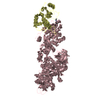



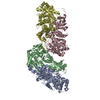

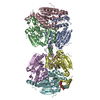

 PDBj
PDBj






